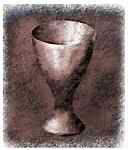Steps of the Dance
 I have observations and questions about communion -- maybe this should be two posts.
I have observations and questions about communion -- maybe this should be two posts.My current experiences with communion come from mainly two sources (although not exclusively). Our church participates in communion one Sunday every other month, and Steve and I attend our Emmaus Community Gatherings, which always include communion. I love to watch for symbolism, and communion is rife with it.
Before I show you my list, please understand that these items I list are only the steps of the dance. They are not the purpose of the dance; therefore, let's not place too high a value on them.
- Our sanctuary has four sections of pews and five aisles (you can kind of get an idea of that here). If I were to number them, I would call the two very side aisles -- along the edge -- 1 and 5, the center aisle would be 3. That leaves aisles 2 and 4 to divide the room into quarters. I know others (3/21/06) disagree with me (and isn't that fun?), but I really like the way we use these aisles to approach communion. Ushers invite each pew, from the front to the back, to travel down aisles 2 and 4 toward the back. We cross across the back of the sanctuary, and then meet together in the center aisle, to walk toward those serving communion. Isn't it strange that the one communion dance step that would remind me the most of the walk to Emmaus doesn't happen at an Emmaus gathering? It is part of my church's tradition. The walk can be long, and can seem to be unnecessary, but the journey is important. I like that we walk so far -- just as on the Walk to Emmaus, God knows we need the time to make the journey. (And, really, do we need to be in a hurry?) I also like that we come together as a church (one aisle) to approach communion. It's all symbolism, but I think it adds to the richness of the experience.
- At an Emmaus Gathering, those in the back of the sanctuary are the first to be served. The first shall be last -- to me this embodies one of the principles of the Emmaus walk -- putting others first.
- Also at the gatherings, the community approaches communion linked -- the person behind walking with a hand on the shoulder of the person in front. At the actual time of service, the front person turns and maintains contact with one who had been behind him -- what better symbolism could there be for community support?
- Last Sunday, when we participated in Communion at our church, we were served the "wine" in the cute little disposable communion cups. We received the bread and wine at the end of the aisle, and than carried it to the altar rail. After communion and prayer, you leave the little cup on the railing and then go back to your seat. Do you see the symbolism there? You carry the cup to the railing, and then leave it behind. You carry your burdens to the altar, and then leave them behind. Sins, problems, worries, separation, anxiety, distractions, heavy, tormented hearts -- all brought to the altar, and then left behind with the dirty dishes.
If communion is a means to experiencing God's grace, then I think these moments of symbolism are like the landing lights on a runway, directing the jet safely home.
(Yep, my questions about communion will have to wait for another post.)
Image from Hermanolean clipart

0 Comments:
Post a Comment
<< Home